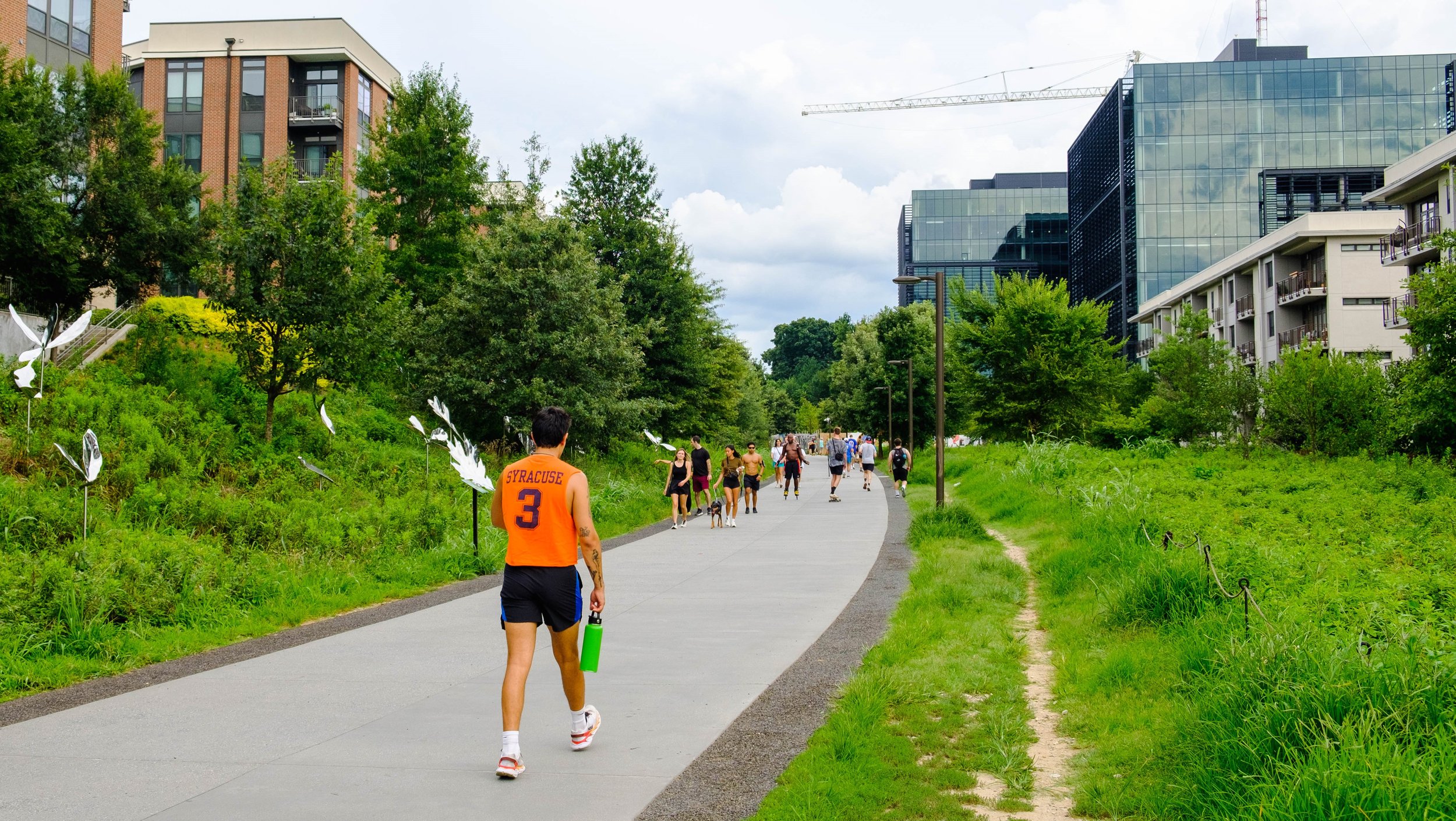MYTHBUSTER #2: ‘The founding idea for the Beltline is transit’
Grade: It’s Complicated
First, a caveat: “It was always in the plan” is never a good argument. Especially, when you’re talking about $2.5 billion. Unbuilt transit concepts aren’t chiseled in stone.
That said, today’s Beltline looks a lot like a rehabilitation of the nearly abandoned “belt lines” that was envisioned in the city’s 1993 long-term greenspace plan:
“Imagine a cultural ring, around Downtown and Midtown, which is a circular greenway park with a pedestrian/bicycle trail. …. Cafes, restaurants and entertainment could locate in the area. Artists could find affordable space to live, work and perform, with on-site art galleries. As intown investments and economic development grows, the prestige of the City would be enhanced.”
Sound familiar?
Support for what became the Beltline was city policy even before it was the Beltline. The concept is laid out in the 15-year, City Council-approved 1993 Parks, Open Space and Greenway Trails Plan. The Beltline even owes its funding to the earlier plan’s proposal to finance it through a tax allocation district.
A map of the proposed “Cultural Ring” from the city’s 1993 Parks, Open Space and Greenway Trails Plan. Alycen Whiddon’s concept looked a lot like today’s Beltline.
There are differences, of course. In 1992, the PATH Foundation published a citywide plan that included a trails-only loop along the nearly abandoned “belt lines” that encircled the inner city.
The next year, the more ambitious “cultural ring,” which added a short segment of rail, was conceived by a real hero of the Beltline: the late Atlanta city planner Alycen Whiddon.
Whiddon’s plan was to transform the abandoned rail rights-of-way into connected greenspaces that would spur economic development, which is precisely what has happened. But she placed a heavy emphasis on cultural events. In the southwest quadrant, her route cut closer than the current Beltline to downtown to connect to a New Georgia Railroad “excursion train route on the west side.”
The ring concept got a boost in the run-up to the 1996 Olympics. The Corporation for Olympic Development in Atlanta (CODA), an entity formed to leverage the games for the city’s benefit, suggested a version that included a rubber-tire electric shuttle.
Amid Atlanta’s Olympic makeover, however, the idea of the Cultural Ring wasn’t quite ripe. Freight railroads retained control over the right of way, trail construction would require some lead time, and the electric shuttle technology hadn’t fully developed.
Still, the long-term parks plan was in place to guide greenspace development well into the early years of the Beltline.
After the Olympics, CODA Planning and Development Director Randy Roark returned to his permanent position as a Georgia Tech planning professor. He soon became thesis advisor to a master's student named Ryan Gravel.
Gravel’s 1999 thesis didn’t include a multi-use trail at all. His Beltline would have consisted only of fixed-rail. His core argument: Rail was the essential element to spur development and connect the entire loop to struggling neighborhoods.
City Council President Cathy Woolard embraced Gravel’s thesis and garnered public support. But the city stopped short of adopting Gravel’s rail-only concept. Instead, after much study, Atlanta Beltline Inc. adopted the more pragmatic approach. Before getting started on rail, ABI would build out the trail, as well as an “Emerald Necklace” of parks connected by the Beltline.
That game plan was reflected in the Atlanta Development Authority’s 2005 Atlanta Beltline Redevelopment Plan. It endorsed “transit.” But it kicked design and construction down the road, and it didn’t specify that the transit must be rail.
Then-Mayor Shirley Franklin recollected her earlier thinking in a 2022 TV interview: “We can do trails and we can do parkway, kind of a linear park, and we believe we that we can set aside money for affordable housing and make it accessible to everyone. And maybe someday someone will be able to do light rail and transit.”
The city adopted a broader vision of the Beltline than the one proposed by Ryan Gravel’s plan, which would have had a rail line but not trails and parks.
For most of the loop’s length, Atlanta Beltline Inc. has dutifully – and expensively – reserved a right-of-way for transit. And about a decade ago, Mayor Kasim Reed tasked ABI to come up with a transit plan – a questionable approach, given ABI’s stake in one particular project. Unsurprisingly, ABI proposed 51 miles of streetcars, including all 22 miles of the Beltline.
The history makes it clear: From early on, two priorities have vied for primacy when it comes to the Beltline dream and its resources: One to develop trails and parks; the other to install transit.
Thirty years after the City Council adopted Whidden’s cultural ring and 24 after Gravel’s Beltline thesis, the Beltline looks quite a bit like the former. As it turns out, that version of the Beltline has been wildly successful without rail.
With a big boost from electric bikes and scooters, thousands every day already use the Beltline for transportation. And other than the moribund downtown Atlanta Streetcar, the rest of that streetcar network envisioned in ABI has been shelved because there’s not enough More MARTA money for them.
On the east side, development has exceeded expectations. Similar success seems to be following to the south and west. Doesn’t that render the original argument for the rail (that it was necessary to draw development) superfluous? Yet streetcar advocates continue to push for an outmoded vision …
… which brings us back to our caveat: Who says we must rigidly adhere to one particular vision – let alone a 24-year-old thesis that didn’t even include the trails and parks that now exist on the Beltline? Plans change, as they have many times during the history of the Beltline.
In a 2005 “Addendum to the Beltline Thesis,” Gravel wrote: “The Beltline continues to evolve – and it should. Hopefully, together we will make it into something even better than the original vision.”
We couldn’t agree more.
— Ken Edelstein




